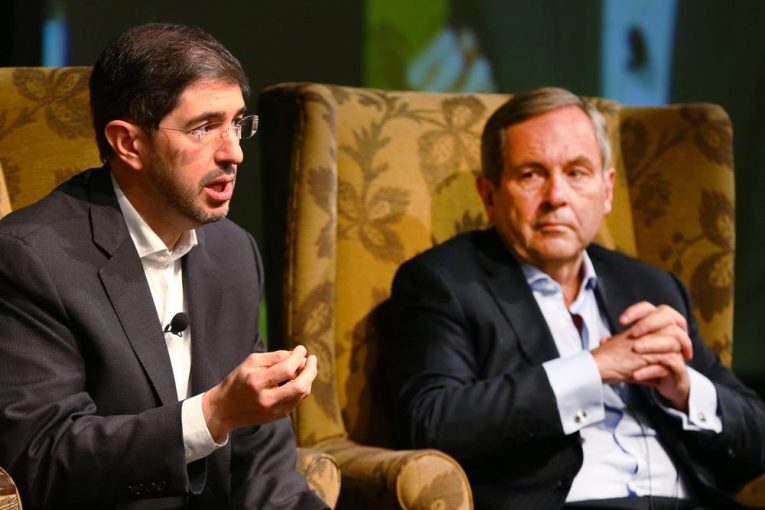
BANFF — As NAFTA negotiations resume Saturday, Canada’s ambassador to the United States isn’t worried about the sprawling energy relationship being side-swiped during the trade talks.
In fact, David MacNaughton believes the energy file is an area that can be enhanced as the third round of the trilateral discussions begin in Ottawa.
“Energy is more of an opportunity than a problem,” MacNaughton said in an interview Friday, before speaking at the Global Business Forum.
“Every discussion we’ve had with the Americans about energy has been a positive discussion, it’s about how do we make it work better.”
This would be good news for the Canadian oilpatch, which is closely tethered to our southern neighbours.
The United States effectively remains the only customer for Canadian oil exports. As production from the oilsands continues to grow, that’s not about to change anytime soon.
While Canada twists itself into knots about building new pipelines that would move crude to tidewater, 99 per cent of our oil exports went south last year, worth US$36 billion.
U.S. President Donald Trump has given his approval to the long-awaited Keystone XL pipeline; if it’s eventually built by TransCanada Corp. the project would boost the volume of oil heading south.
But this isn’t a one-way relationship.
Canada remains the largest source of foreign oil for the Americans, supplying 41 per cent of all imports to the United States.
Producers in the country also shipped about eight billion cubic feet per day of gas into the lower 48 states, valued at almost US$6 billion.
Booming gas production from the Marcellus and Utica shale formations also means U.S. gas being sold into Canada increased to 2.1 bcf per day last year. That figure is likely to climb in the years ahead.
This file isn’t just important to the sector or the province; it’s important to the country and thousands of trade-related jobs.
Oil, gas and electricity accounted for more than 19 per cent of the value of all U.S. imports from Canada in 2016, according to the U.S. Energy Information Administration.
Yet, just because there’s a mutual benefit for both sides doesn’t mean energy is in the clear.
Trump identified Canadian energy as a problem in April, although no one seemed to know what he was talking about.
There are also areas of potential improvement that will be discussed.
Industry groups like the American Petroleum Institute, Canadian Association of Petroleum Producers and Mexican Association of Hydrocarbon Companies say “NAFTA works,” although they’d like to see improvements in labour mobility for energy workers.
“We are interested in enhancing labour mobility in every sector, including energy,” said MacNaughton, noting Natural Resources Minister Jim Carr has been speaking with U.S. Energy Secretary Rick Perry about a North American energy framework.
“Whether that is part of a side deal, whether it becomes part of NAFTA, I think is still open to some discussion …
“But I think we’re trying to find areas of mutual co-operation. It’s a huge relationship on energy between Canada and the United States and increasingly Mexico has opened up its energy market.”
Speaking on the sidelines of the forum, Mexico’s ambassador to Canada, Dionisio Perez Jacome, noted his country didn’t sign on to the energy chapter within NAFTA 23 years ago because the sector was still owned and controlled by the government.
Since 2013, Mexico has opened its oil industry to outside investment and would look at NAFTA in a new light on this front.
“We are in a position to reflect that openness in the agreement; we weren’t in that position before when NAFTA was originally signed,” he said.
However, all of these soothing signs don’t mean the weekend talks will go smoothly.
Trump has called NAFTA the worst trade deal in history, and the threat of the U.S. pulling out of the pact looms.
The thorny issue surrounding rules of origin is expected to rear its head, amid demands by U.S. Trade Representative Robert Lighthizer that the deal require higher NAFTA content in automobiles and parts — particularly higher American content.
Other problem spots could include the trade-resolution mechanisms within the current agreement, as well as Canada’s supply management system for dairy, egg and poultry.
Hal Kvisle, the former CEO of TransCanada, said people in the sector generally aren’t worried about the negotiation’s impact on the energy industry, given the obvious benefits to all three countries.
“The only thing that could come out of NAFTA would be is if there’s a general breakdown in the trade relationship between the two countries,” he said while in Banff.
“Then energy would, to some extent, get caught up in it.”
For all the potential pitfalls, MacNaughton maintained the first two rounds of discussion in Washington and Mexico City were productive and progress was made.
While there’s talk of a need to reach a deal before Christmas, he doesn’t think the obstacles are insurmountable.
“I’m still optimistic,” he added.
“Maybe we can do this in three months. It’s going to take an extraordinary amount of goodwill to have that done. And I think there is goodwill. We’ll see.
“But I think at the end of the day, NAFTA is an important economic benefit to all three countries.”
Chris Varcoe is a Calgary Herald columnist.
You can read more of the news on source
